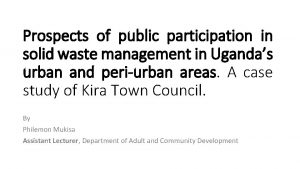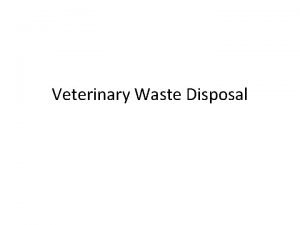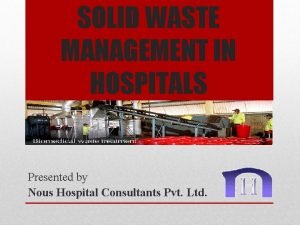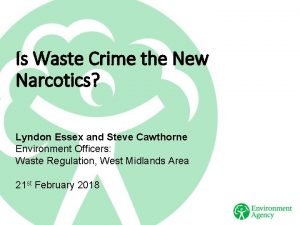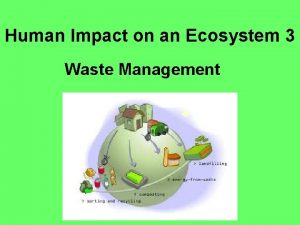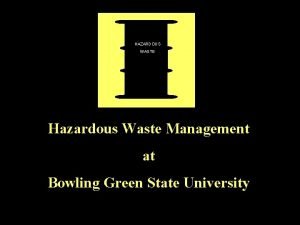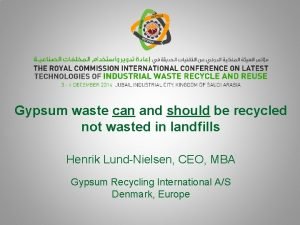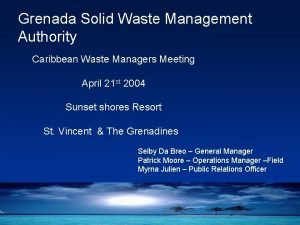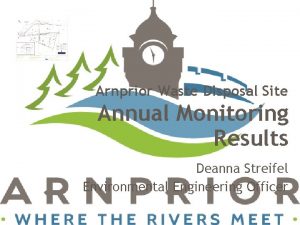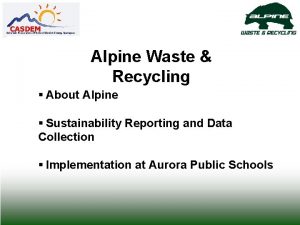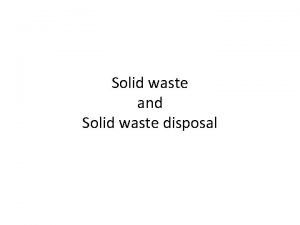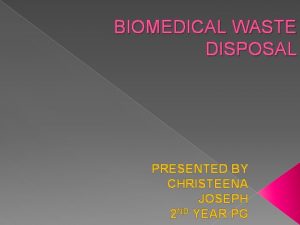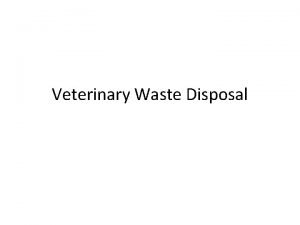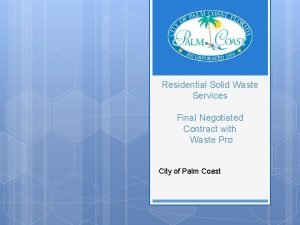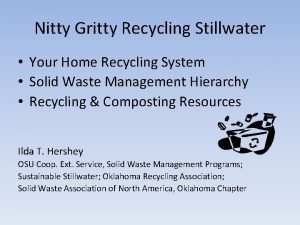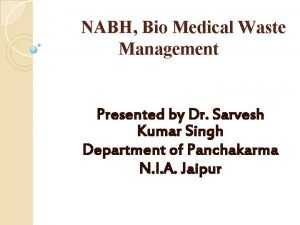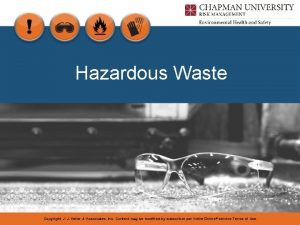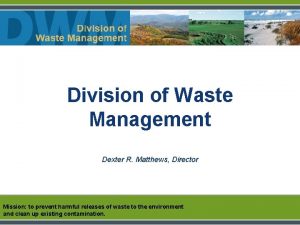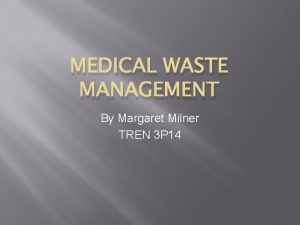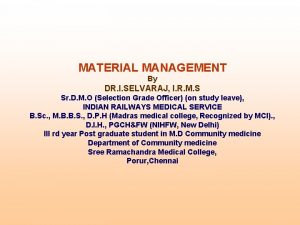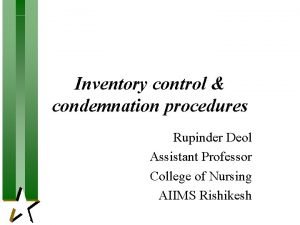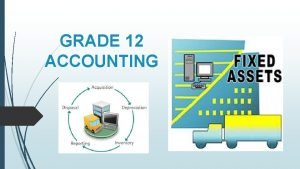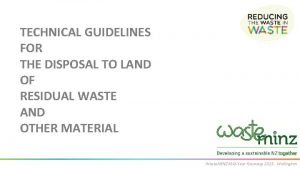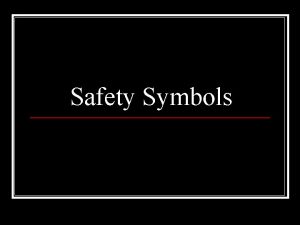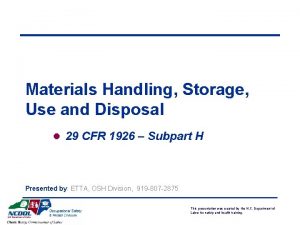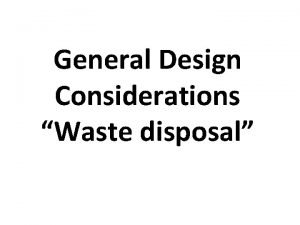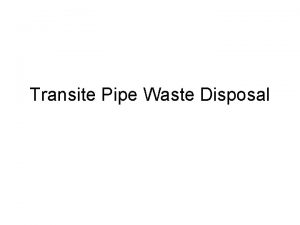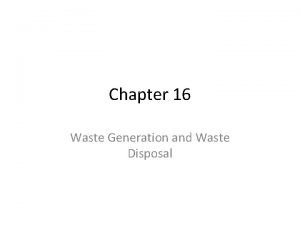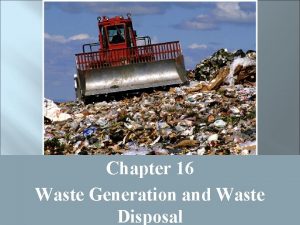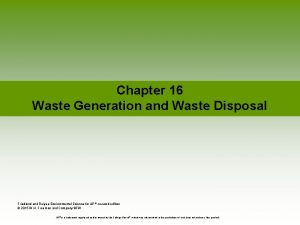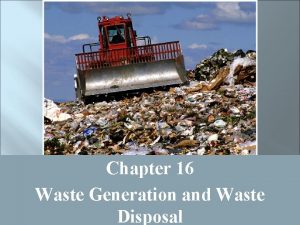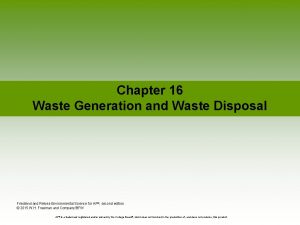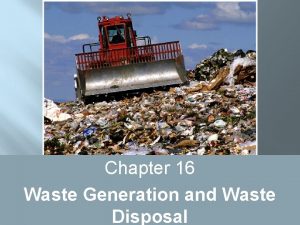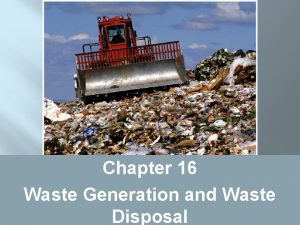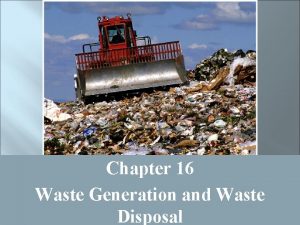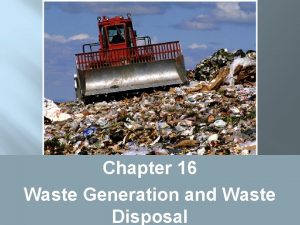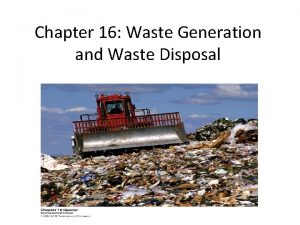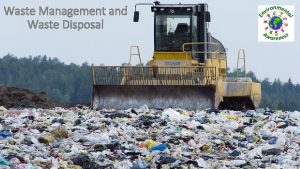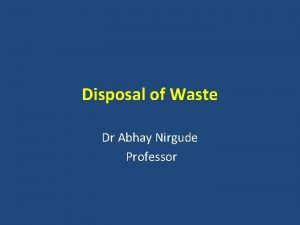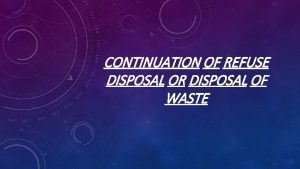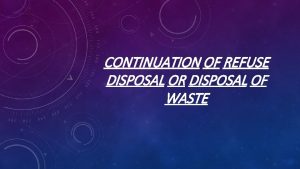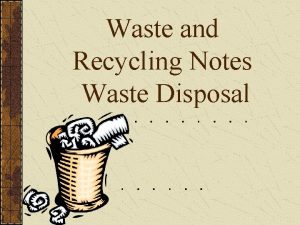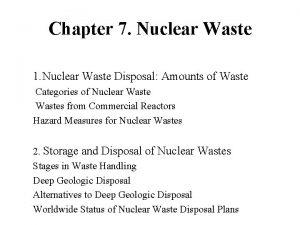Chapter 16 Waste Generation and Waste Disposal Introduction
































- Slides: 32

Chapter 16 Waste Generation and Waste Disposal

Introduction: Paper or Plastic When looking at waste generations what factors should we consider in what materials we use? - recyclable? - energy cost? - pollution (manufacturing, transportation, etc. ) - overall cost - disposal Foam Facts

Everything is a System

Throw-Away Society Are we a throw-away society? Why or Why not? What factors contributed to a throw-away society?

Municipal Solid Waste Refuse collected by municipalities from households, small businesses, and institutions such as schools, prisons, municipal buildings and hospitals.


Composition of Municipal Solid Waste 31% - paper 33%- organic materials (yard waste, food scraps, wood) 12%- plastic 18%- durable goods (appliances, tires)

E-Waste Electronic waste (E-waste) televisions, computers, cell phones that contain toxic metals. 2% of total waste. Will it increase in the future?

Reduce, Reuse, Recycle Reduce- waste minimization or prevention One approach by Source Reduction – during design and manufacturing. Example:

Reduce, Reuse, Recycle Reuse- reusing something like a disposable cup more than once Example:

Reduce, Reuse, Recycle- materials are collected and converted into raw materials and then used to produce new objects Closed-Loop Recycling – recycling the product back into the same product Example: Open-Loop System – recycled products are recycled into a different product Doesn't decrease demand for primary product. Example: Use resources that have already been extracted?

Reduce, Reuse, Recycle What is the order of preference? Why?



Composting Compost- organic material that has decomposed under controlled conditions to produce an organicrich material.

Composting Organic material: plant materials, grass, veggies, animal manure, leaves, etc. Avoid Must have a proper Carbon to Nitrogen Ratio (30: 1) to promote proper aerobic decomposition Anaerobic decomposition produces methane and other gasses. Good meat and dairy products. or bad? Composting Advantages vs. Disadvantages?


Landfills Sanitary landfills- engineered ground facilities designed to hold MSW with as little contamination of the surrounding environment as possible. Leachate- the water that leaches through the solid waste and removes various chemical compounds with which it comes into contact.

Landfills Best liner for land fills? Leachate Collecting System Tipping Fee - $35+ per ton Siting – designation of a landfill location. NIMBY Water Contamination Problems with Landfills? Lechate Odor Vermin Space Decomposition


Incineration Incinerationthe process of burning waste materials to reduce its volume and mass and sometimes to generate electricity and heat.

Incineration Ash – nonorganic that does not combust completely Bottom Ash – collected underneath the furnace Fly Ash – Collected beyond the furnace. Ash can contain toxic metals. Safe Ash can be used road construction, cement, flooring

Incineration Good: Waste to Energy – using waste to create energy Waste Reduction Reuse (road, flooring) Problem with Incineration: NIMBY Higher Tipping Fee Air Pollution Ash Production Does not encourage 3 R’s. Incomplete Burns

Hazardous Waste Hazardous waste- liquid, solid, gaseous, or sludge waste material that is harmful to humans or ecosystems. Collection sites for hazardous waste must be staffed with specially trained personnel. Hazardous waste must be treated before disposal. Treatment : less environmentally harmful Examples: household cleaners, motor oil, oil based paints, etc.

Laws Resource Conservation and Recovery Act (RCRA)designed to reduce or eliminate hazardous waste. Also know as “cradle-to-grave” tracking. RCRA ensures that hazardous waste is tracked and properly disposed of. Modified with the HSWA (Hazardous and Solid Waste Amendment) in 1984.

Laws Comprehensive Environmental Response, Compensation, and Liability Act (CERCLA)- also know as “Superfund”. Puts a tax on the chemical and petroleum industries. This revenue is used to cleanup abandoned and nonoperating hazardous waste sites where a responsible party cannot be found. Requires the federal government to respond directly to the release of substance that may pose a threat to human health or the environment NPL (National Priority List) maintained by EPA

Superfund Most Superfund Sites (2010)? New Jersey with 114 California and Pennsylvania tied for 2 nd most with 94. Every state has at least one superfund site except for North Dakota.

Brownfields Contaminated industrial or commercial sites that may require environmental cleanup before they can be redeveloped or expanded. Old factories, industrial areas and waterfronts, dry cleaners, gas stations, landfills, and rail yards are some examples. Does not meet superfund designation of high risk to public health.

International Waste Exchange Why? Examples:

Life Cycle Analysis of Solid Waste Looks at the life time of a product. Can be very difficult to analyze. Why?

Integrated Waste Management A method that seeks to develop as many options as possible, to reduce environmental harm and cost. Reduction, recycling, composting, landfills, and incineration are some ways IWM is utilized.

 Solid waste disposal introduction
Solid waste disposal introduction Lindsay waste collection
Lindsay waste collection Veterinary waste management
Veterinary waste management Color coding for waste disposal
Color coding for waste disposal Waste disposal lyndon
Waste disposal lyndon 3 waste segregation
3 waste segregation Screw feed technology of waste management
Screw feed technology of waste management Waste manifest
Waste manifest Can gypsum be recycled
Can gypsum be recycled Garbage service grenada
Garbage service grenada Arnprior waste disposal site
Arnprior waste disposal site Alpine waste
Alpine waste Summary of biomedical waste management
Summary of biomedical waste management Controlled tipping is a method of disposal of
Controlled tipping is a method of disposal of Introduction of biomedical waste
Introduction of biomedical waste Veterinary waste
Veterinary waste Refuse disposal meaning
Refuse disposal meaning Palm coast waste services
Palm coast waste services Stillwater ok waste disposal
Stillwater ok waste disposal Nabh criteria for hospital
Nabh criteria for hospital Hazardous waste transportation
Hazardous waste transportation Grenada disposal of garbage
Grenada disposal of garbage Matthews waste disposal
Matthews waste disposal Milner waste
Milner waste First generation antipsychotics
First generation antipsychotics Lord your mercy endureth forever
Lord your mercy endureth forever Retention and disposal of gmp documents
Retention and disposal of gmp documents Condemnation and disposal in material management
Condemnation and disposal in material management Condemnation in material management
Condemnation in material management Grade 12 accounting fixed assets
Grade 12 accounting fixed assets Technical guidelines for disposal to land
Technical guidelines for disposal to land Sharp objects symbol
Sharp objects symbol When disposal materials are dropped
When disposal materials are dropped
